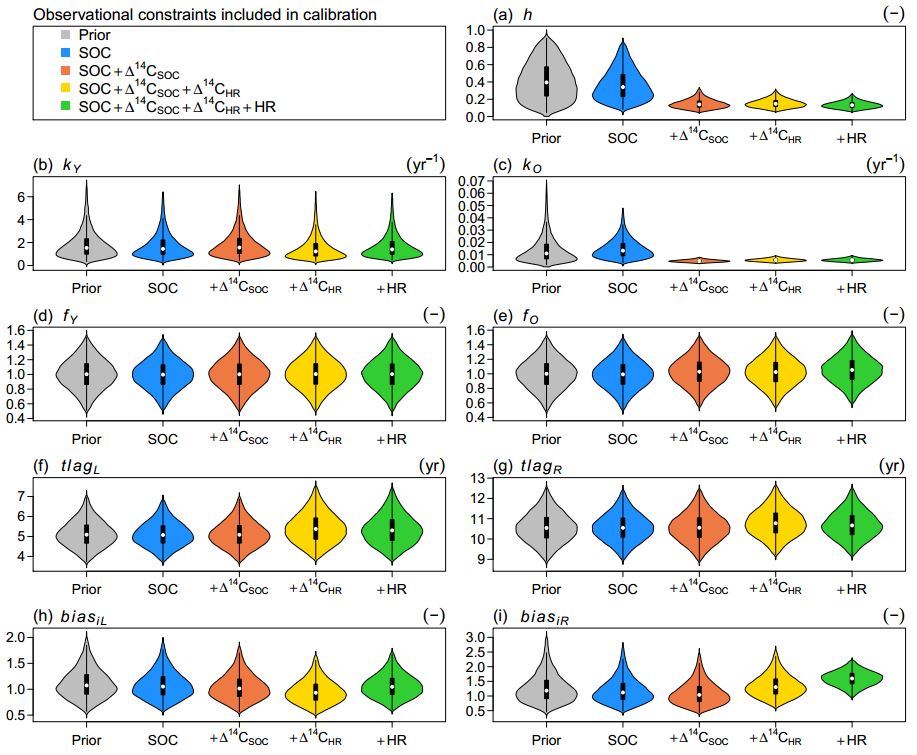Ahrens, B., Reichstein, M., Borken, W., Muhr, J., Trumbore, S. E., and Wutzler, T.: Bayesian calibration of a soil organic carbon model using Δ14C measurements of soil organic carbon and heterotrophic respiration as joint constraints, Biogeosciences, 11, 2147-2168, doi:10.5194/bg-11-2147-2014, 2014.

Howland Tower. Violin plots of the posterior distributions of parameters using different combinations of observational constraints. More information in the original paper.
Abstract
Soils of temperate forests store significant amounts of organic matter and are considered to be net sinks of atmospheric CO2. Soil organic carbon (SOC) turnover has been studied using the Δ14C values of bulk SOC or different SOC fractions as observational constraints in SOC models. Further, the Δ14C values of CO2 that evolved during the incubation of soil and roots have been widely used together with Δ14C of total soil respiration to partition soil respiration into heterotrophic respiration (HR) and rhizosphere respiration. However, these data have not been used as joint observational constraints to determine SOC turnover times. Thus, we focus on (1) how different combinations of observational constraints help to narrow estimates of turnover times and other parameters of a simple two-pool model, the Introductory Carbon Balance Model (ICBM); (2) whether relaxing the steady-state assumption in a multiple constraints approach allows the source/sink strength of the soil to be determined while estimating turnover times at the same time. To this end ICBM was adapted to model SOC and SO14C in parallel with litterfall and the Δ14C of litterfall as driving variables. The Δ14C of the atmosphere with its prominent bomb peak was used as a proxy for the Δ14C of litterfall. Data from three spruce-dominated temperate forests in Germany and the USA (Coulissenhieb II, Solling D0 and Howland Tower site) were used to estimate the parameters of ICBM via Bayesian calibration. Key findings are as follows: (1) the joint use of all four observational constraints (SOC stock and its Δ14C, HR flux and its Δ14C) helped to considerably narrow turnover times of the young pool (primarily by Δ14C of HR) and the old pool (primarily by Δ14C of SOC). Furthermore, the joint use of all observational constraints made it possible to constrain the humification factor in ICBM, which describes the fraction of the annual outflux from the young pool that enters the old pool. The Bayesian parameter estimation yielded the following turnover times (mean ± standard deviation) for SOC in the young pool: Coulissenhieb II 1.1 ± 0.5 years, Solling D0 5.7 ± 0.8 years and Howland Tower 0.8 ± 0.4 years. Turnover times for the old pool were 377 ± 61 years (Coulissenhieb II), 313 ± 66 years (Solling D0) and 184 ± 42 years (Howland Tower), respectively. (2) At all three sites the multiple constraints approach was not able to determine if the soil has been losing or storing carbon. Nevertheless, the relaxed steady-state assumption hardly introduced any additional uncertainty for the other parameter estimates. Overall the results suggest that using Δ14C data from more than one carbon pool or flux helps to better constrain SOC models.
Biogeosciences
Biogeosciences (BG) is an international scientific journal dedicated to the publication and discussion of research articles, short communications and review papers on all aspects of the interactions between the biological, chemical and physical processes in terrestrial or extraterrestrial life with the geosphere, hydrosphere and atmosphere. The objective of the journal is to cut across the boundaries of established sciences and achieve an interdisciplinary view of these interactions. Experimental, conceptual and modelling approaches are welcome. More at Biogeosciences homepage.


Cuthbertsonlairdgroup
Great article!! Appreciate the information. Well done.